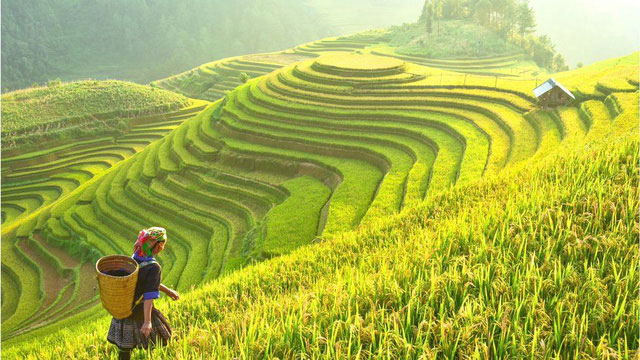Rice is safely preserved in Philippine gene bank
Scientists said more than 100 thousand different varieties of rice have been preserved for the future at the International Rice Institute.
Samples in the world's largest rice gene bank in the Philippines will be used to help farmers create rice crops that can survive singing and flooding.
has found long-term funding from Crop Trust.
It is part of international efforts to store seeds in gene banks to protect the warming world food supply.
Marie Haga, executive director of the non-profit international organization, Crop Trust, said: 'These seeds are miracles - we believe that in the natural variety of rice, you have almost every feature you want to search for '.
She said rice is relatively easy to store, and will overcome hundreds of years of low-temperature conservation.
Rice has a genetic diversity that can be used to propagate new rice resistant to pests and diseases as well as inundation and drought.

Rice is being harvested in northwestern Vietnam.
The facts about rice
- Rice accounts for more than 20% of global calories.
- More than 90% of world rice is produced and consumed in Asia with six countries (China, India, Indonesia, Bangladesh, Vietnam and Japan) accounting for 80% of world production and consumption.
- By 2050, annual rice consumption is estimated to increase from 420 to 525 million tons.
A recent achievement by IRRI, based in Los Banos, Philippines, is a rice variety that can live in flooded areas.
'Diving rice' has been introduced in Asia and is being adapted to grow in Asia.

IRRI gene bank holds wild rice varieties from around the world - (Photo from IRRI).
Ruaraidh Sackville-Hamilton, a genetic biologist who manages gene banks IRRI, said rice conservation has a proven track record to benefit the world.'With this collection safely preserved, we can continue to use it to create improved rice varieties that farmers can use to cope with challenges in rice production, and adapt to changing tastes and preferences of consumers everywhere '.
- Preserving rice genes in IRRI
- Vietnamese professors enrich the bank of precious rice genes
- Gene helps increase rice yield and quality
- Discovering a new kind of rice gene for high yield
- New rice varieties improve productivity for Asia
- Looking for rice varieties
- Published a complete map of the genetic variation of rice
- Vietnam has the first tissue bank
- Gene mutations create the aroma of jasmine rice
- The 1 million seed is put into the bank
- Instructions on how to preserve cold rice so that it is not harmful to health
- Respiratory mutation techniques to create protein-rich rice varieties
 Why do potatoes have eyes?
Why do potatoes have eyes? 'Tragedy' the world's largest carnivorous life: Death becomes ... public toilet
'Tragedy' the world's largest carnivorous life: Death becomes ... public toilet Tomatoes were once considered 'poisonous' for 200 years
Tomatoes were once considered 'poisonous' for 200 years Detecting microscopic parasites on human face
Detecting microscopic parasites on human face